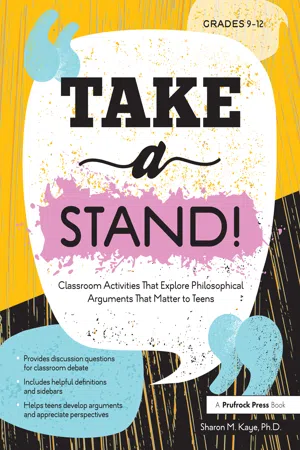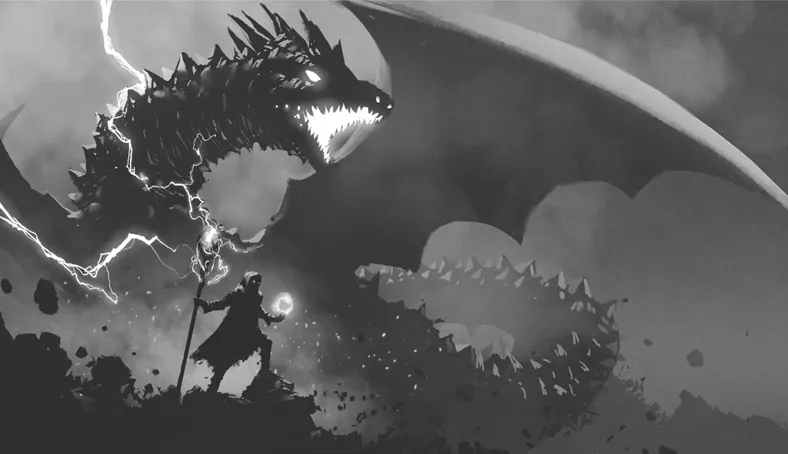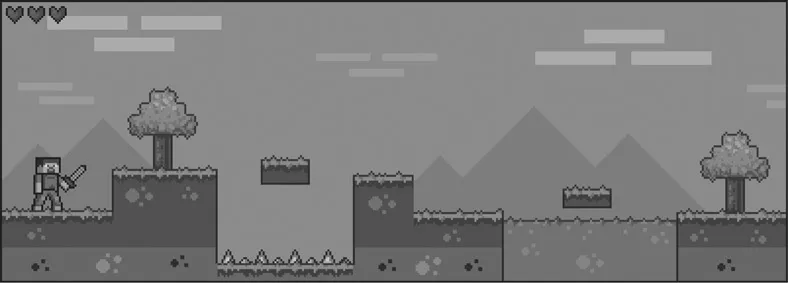
eBook - ePub
Take a Stand!
Classroom Activities That Explore Philosophical Arguments That Matter to Teens
This is a test
- 146 pages
- English
- ePUB (mobile friendly)
- Available on iOS & Android
eBook - ePub
Take a Stand!
Classroom Activities That Explore Philosophical Arguments That Matter to Teens
Book details
Book preview
Table of contents
Citations
About This Book
Take a Stand! (grades 9-12) helps teens develop critical thinking skills by examining debates on issues directly relevant to their lives (that you won't find in most classroom materials). Each chapter:
- Covers an important topic relating to electronics, sex, mental health, and relationships.
- Presents a question for debate, such as "Should kids choose their own religion?" and "Is it possible to love more than one person?"
- Shows how each issue might arise in an ordinary teen conversation.
- Presents and explores two or more opposed answers to philosophical debates.
- Encourages high school students to develop their own positions while learning to appreciate other perspectives.
Throughout the book, the chapter contributors—all current or recent teens themselves—highlight key definitions, quote compelling sources, and diagram the central arguments. Each chapter includes discussion questions to guide arguments, as well as helpful sidebars and illustrations to increase comprehension. Perfect for inspiring classroom discussion of topics that matter to today's teens.
Grades 9-12
Frequently asked questions
At the moment all of our mobile-responsive ePub books are available to download via the app. Most of our PDFs are also available to download and we're working on making the final remaining ones downloadable now. Learn more here.
Both plans give you full access to the library and all of Perlego’s features. The only differences are the price and subscription period: With the annual plan you’ll save around 30% compared to 12 months on the monthly plan.
We are an online textbook subscription service, where you can get access to an entire online library for less than the price of a single book per month. With over 1 million books across 1000+ topics, we’ve got you covered! Learn more here.
Look out for the read-aloud symbol on your next book to see if you can listen to it. The read-aloud tool reads text aloud for you, highlighting the text as it is being read. You can pause it, speed it up and slow it down. Learn more here.
Yes, you can access Take a Stand! by Sharon M. Kaye in PDF and/or ePUB format, as well as other popular books in Education & Education General. We have over one million books available in our catalogue for you to explore.
Information
PART I
TECHNOLOGY

Chapter 1
Are Video Games a Waste of Time?
DOI: 10.4324/9781003238393-3
[Annie rings Sean’s doorbell and asks him to join her on a bike ride.]
Sean: Why don’t you come inside instead and check out this new video game I got!
Annie: [Glancing into the house at the television screen] Oh, that game. My brother has been playing that. It’s a waste of time.
Sean: What do you mean? I played last night, and it was loads of fun.
Annie: Yeah, maybe it is, but my brother plays it for about 5 hours a day. He’s like a zombie, just pressing buttons and staring at the screen.
Sean: I’ll admit it’s easy to get hooked on video games. But it’s okay with this one because it has a great story.
Annie: Well, I can see how video games might be okay for kids learning how to read, or type, or build simulations. But otherwise they’re just a waste of time.
Sean: Something’s not a waste of time if you enjoy it. Is it a waste of time to look at a painting in an art museum?
Annie: Of course not. Great paintings inspire people in so many ways.
Sean: Exactly, and playing a great video game isn’t any different from enjoying great art.
Annie: Games aren’t the same as art at all. They’re competitive. You spend all of your time trying to outdo other people.
Sean: First of all, what’s wrong with competition? Do you blame Olympic gold medalists for spending all of their time trying to outdo other people? Second, not all games are competitive. In some, you build cool things, sometimes with other people.
Annie: Olympic gold medalists, artists, and carpenters get a lot more fresh air and exercise than button mashers do.
Sean: I grant that everyone needs some fresh air and exercise. But a lot of professions require grown adults to sit at computer monitors for 8 hours a day. It’s hypocritical to say that’s okay for adults but not for kids.
Annie: All I know is that I’m glad I have other hobbies. See you around.
Art: A form of creative expression, produced and appreciated by humans for its beauty and emotional power.
Competition:
An activity in which people work against one another to gain something.
Video games are generally adored by young people and disliked by parents. Whether the game of choice is a multiplayer shooter or a single-player platformer, it can absorb its players for hours on end and become a distraction from real-life affairs. Many scientific articles have criticized video games for their influence on the developing minds of young people, while countless bloggers and game reviewers argue that video games are thought-provoking, mentally enriching, and even an art form in themselves.
So how should people regard video games? Are they a waste of time, or can they lead people to think deeply—even philosophically—in ways that they haven’t before? Many 21st-century thinkers have tried to answer these questions.
Aaron Smuts argued that art has many definitions and can take many forms; video games would count as an art form based on most of these definitions. He also pointed out that museums have begun including video games in their more contemporary, interactive exhibits. Smuts admitted that not all video games should count as art. In particular, he maintained that some games are competitive in nature, which makes them pastimes, in his view, rather than art.
Anyone who has played a single-player adventure game knows that not all video games promote competition. Some have a focus on storytelling and providing a sensory experience for the player. Smuts pointed to the increasing visual detail of video games as proof of artistic merit. Developers are also putting more and more effort into the accompanying music. Smuts believed video games can be considered art even though they are competitive. After all, poems and other art forms can be created for the purpose of competition without undermining their artistic nature.
Smuts’s Argument FOR Video Games
- Some video games are art.
- Appreciating art is a valuable experience.
- Playing a video game is a way of appreciating it.
- Therefore, playing some video games is a valuable experience.
Gambling: Playing a game of chance, typically one that involves betting money.
However, it’s possible that video games could still be a waste of time if their value as art is being ignored. The competitive nature of a video game could absorb the players’ attention, distracting them from the beauty that makes the game art. People typically play a game for hours upon hours because they enjoy the competition. If this kind of competition is a waste of time, then playing wouldn’t be the same as appreciating art. For example, have you ever enjoyed the way a game looks or found yourself interested by its story, only to forget about these things once you begin competing for the fastest time or the most victories?

But distraction is not the only problem with competition. Jeffrey Barlow showed how the competitive nature of video games could promote gambling and even normalize violence. Barlow explained that when people compete against each other online, they can motivate one another to spend unhealthy amounts of time playing. They are missing out on fresh air, sunshine, and physical human contact. Some players end up losing sleep, eating poorly, and even dying as an effect of their unhealthy interest in continuing to play video games.
Moreover, the world of gaming offers many opportunities for attaching monetary value to winning—but this is gambling. Kids lack sufficient understanding of personal finances to be responsible gamblers. They also might begin to expect a prize for everything they do, which is not a very realistic approach to life.
Finally, the violence included in games might affect players’ behavior in a variety of ways. Barlow specifically mentioned that Doom, a popular video game, was connected to the first high school shooting in the United States. Repeatedly engaging in violence during gaming can normalize violence for the player, making it more likely for them to be violent in real life.

Barlow’s Argument AGAINST Video Games
- Most video games are competitive.
- Competition could lead to an obsessive interest in the game.
- Obsessive interests are not healthy.
- Therefore, most video games are not healthy pastimes.
Interestingly, kids’ sports are also very competitive. Suppose Joe is so determined to win the state basketball championship that he practices day after day for hours on end. He does the same repetitive drills alone under fluorescent lights at the gym. He loses friends and falls behind in his academic subjects. He grabs fast food for dinner and drinks a lot of Gatorade. He takes his team to the championship. Does Joe have an obsessive interest in basketball? Where does the line fall between a healthy passion and an unhealthy one? If Joe’s passion was for competitive gaming instead of basketball, would his behavior be any more or less healthy?
The 19th-century philosopher John Stuart Mill can help frame questions about video games. Mill famously introduced a distinction between higher pleasures and lower pleasures. Higher pleasures improve people’s overall happiness by activating “higher faculties”—they make people behave in ways that only humans behave. For example, a stirring documentary might motivate you to debate a controversial issue with friends. Lower pleasures, although appealing in the short term, ultimately make people unhappier. For example, watching a silly cartoon for 2 hours won’t motivate you to do anything. In fact, it might make you feel depressed about falling behind on the homework you were supposed to be doing!
Think of a video game you or a friend has played recently. Did the game activate any higher faculties by raising and examining a controversial issue? Did it teach complex information to the player? Did it promote social bonding and problem solving? Or did the game appeal to lower pleasures, such as procrastination? Or was it a mix of both? You may have to analyze the content of each particular game to determine whether and to what extent it is a waste of time.
Personal Statement
I developed a passion for video games at a young age. Like most kids, my fascination with games had to do with their sensory appeal—the bright colors and weird sounds that poured from the screen. As I grew older, I also learned from games. I learned how to stay focused in chaotic environments while playing first-person shooters, and I even picked up important vocabulary from role-playing games. These skills could have been learned in a more academic environment, but I also found value and joy in learning this way because the games themselves were a joy for me.
If I ask myself whether all of my hours spent playing video games could have been spent working toward a greater goal, such as publishing a book, I know that video games were arguably a waste of time. Still, I consider how video games motivated me to make up my own stories and eventually to write them down. I believe the inspiration that I received from gaming made me a more creative person. Without those hours in front of a screen, would I be the avid writer that I am today?
Like many other activities, gaming could be a waste of time if the player is simply using the video game as an escape from their responsibilities or boredom. If the player chooses to experience the game as they would experience a poem or painting, then they might have a more enriching experience.
Discussion Questions
- Think of your favorite video game, or a friend’s. Do you consider it art? Why or why not?
- Think of an avid gamer you know. Do you think that their interest in games might be unhealthy? Why or why not?
- Is there a quality (or set of qualities) that distinguishes an artistic game from a game that might be a waste of time?
- How long is too long to be playing a game? What criteria would you use to determine a healthy time limit?
- What do you think about Mill’s distinction between higher and lower pleasures? Is there an objective way to rate pleasures, or is it all just a matter of opinion?
Classroom Activities
- Make a painting or drawing of video game worlds you would like to create. Share them wit...
Table of contents
- Cover
- Half Title
- Title Page
- Copyright Page
- Table of Contents
- Acknowledgments
- Preface
- Introduction
- Part I: Technology
- Part II: Mental Health
- Part III: Relationships
- Part IV: Sex
- About the Author
- About the Contributors